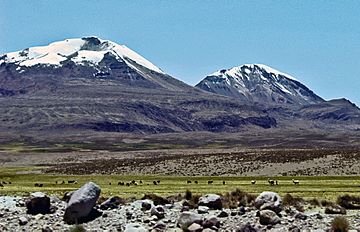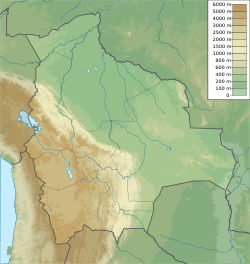Acotango facts for kids
Quick facts for kids Acotango |
|
|---|---|

The volcanoes Acotango (left) and Capurata (right)
|
|
| Highest point | |
| Elevation | 6,052 m (19,856 ft) |
| Prominence | 859 m (2,818 ft) |
| Parent peak | Guallatiri |
| Listing | List of mountains in the Andes |
| Geography | |
| Parent range | Andes |
| Geology | |
| Mountain type | Stratovolcano |
| Last eruption | Pleistocene |
| Climbing | |
| First ascent | 10/14/1965 (first modern ascent) - Sergio Kunstmann, Pedro Rosende and Claudio Meier (Chile) |
| Easiest route | snow/ice climb |
Acotango is a tall volcano located right on the border between Bolivia and Chile. It is the highest peak in a group of three volcanoes. This group is known as Kimsa Chata. Acotango stands at 6,052 meters (about 19,856 feet) high.
The Kimsa Chata group includes Acotango, Umurata (5,730 meters or 18,799 feet) to the north, and Capurata (5,990 meters or 19,652 feet) to the south. These three volcanoes line up from north to south.
Acotango is an old volcano, so it looks very worn down. But a newer lava flow on its northern side suggests it might have been active more recently. Scientists have studied rocks from Acotango. They found that the volcano's rocks are about 192,000 to 241,000 years old. This means it was active a long time ago, during the Pleistocene Ice Age.
Over time, glaciers have carved away parts of the volcano. This has shown some of its inner layers. These inner parts have been changed by hot water, a process called hydrothermal alteration. You can find old glacier marks (called moraines) at about 4,200 meters (13,780 feet) high. Today, a permanent ice cap only exists above 6,000 meters (19,685 feet).
Acotango is a popular spot for hikers. It is part of both the Sajama National Park in Bolivia and the Lauca National Park in Chile. The volcano sits on the border of two areas: Parinacota Province in Chile and Sajama Province in Bolivia. Its slopes are also within the towns of Putre in Chile and Turco in Bolivia.
Climbing Acotango from the Chilean side can be risky because of old land mines. However, it is generally safer to climb from the Bolivian side. The path from the south goes over a glacier and past an old copper mine that is no longer used.
First Climbs and Ancient Visitors
The first modern climbers to reach Acotango's top were Sergio Kunstmann, Pedro Rosende, and Claudio Meier from Chile. They made their successful climb on October 14, 1965.
Pedro Rosende, one of the Chilean explorers, reported finding old firewood at the very top of Acotango. This discovery makes some people think that the mountain might have been a special holy place for the ancient Inca people. The Inca often built shrines on high mountain peaks in the Andes. However, more research is needed to confirm if Acotango was indeed one of these high Inca sanctuaries.
See also
 In Spanish: Cerro Acotango para niños
In Spanish: Cerro Acotango para niños
- K'isi K'isini
- Kuntur Ikiña
- Salla Qullu
- List of volcanoes in Bolivia
- List of volcanoes in Chile
- List of stratovolcanoes


